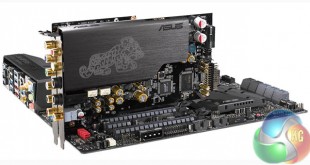
If you use your rig to listen to music then there is a good chance you won't be happy with the onboard sound from the motherboard. ASUS have released the STX II and STX II 7.1 to build on the huge success they experienced from the earlier Essence STX solution. Today we review their follow up sound card and headphone amplifier – the Essence STX II 7.1.
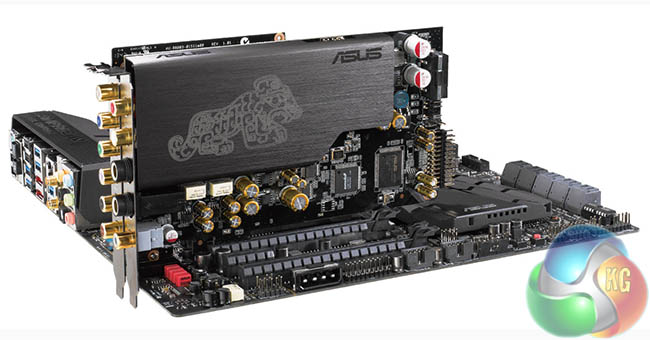
The Essence STX II 7.1 Sound Card is capable of a 124db signal to noise ratio with support for headphones up to 600 ohm impedance. The new product also includes an exclusive OP AMP swap kit to let the end user tweak the sound characteristics. The Essence STX II 7.1 also ships with a daughtercard which offers Ultra Fidelity 7.1 channel audio.
You can see the full list of specifications on this page.
Features:
- Industry-leading 124dB SNR (signal-to-noise ratio) audio quality inherited from the revolutionary and widely-acclaimed Xonar Essence ST/STX
- Ultra-low jitter with premium TCXO clock source
- Clean and consistent power supply thanks to high-fidelity low-dropout (LDO) regulators and WIMA® capacitors for uncompromising sound
- Top-notch headphone amplifier supports up to 600ohm-headphone impedance with additional gain for in-ear monitors (IEMs)
- Exclusive op-amp swap kit includes three op-amps and tool for easy tone tuning
- Celebrated MUSES op-amps deliver true-to-life musicality
- Ultra-fidelity (120dB SNR) 7.1-channel output via the exclusive daughterboard
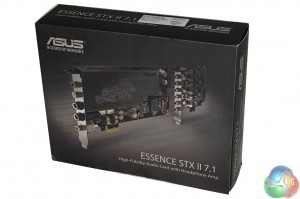
The Essence STX 11 7.1 Sound card ships in a dark box with an image of product clearly visible on the front.
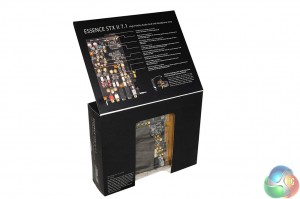
The box opens up gatefold style to reveal the sound card behind a protective clear plastic window. The other side of the box lists some hardware specifications.
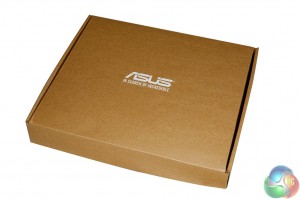
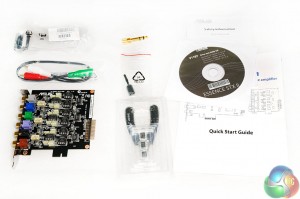
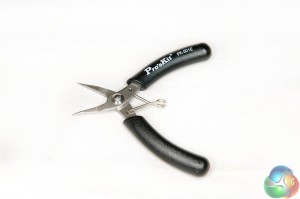
Behind the clear plastic container is a brown box, containing the daughtercard and accessories. which include:
- Op-amp swap kit x 1
- 3.5mm-to-RCA cable x 1
- 6.3mm-to-3.5mm adapter x 0
- S/PDIF adapter x 1
- Driver CD x 0
- Quick start guide x 0
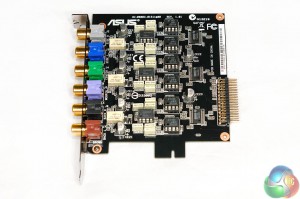
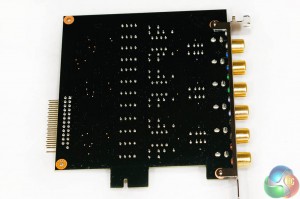
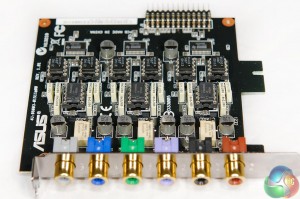
The little daughtercard is a multichannel design which has 7.1 channel support with 120dB SNR outputs. It is paired up with the main sound card which we will picture shortly.
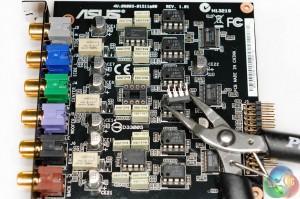
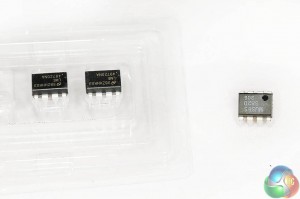
Interestingly ASUS have built in op-amp sockets – meaning that audiophile users can swap these out to change the sound signature. ASUS do supply an OP-AMP ‘swap kit', including the pliers to remove and fit. These are 2x LME 49720 and a single MUSES 8820.
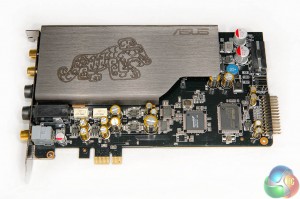
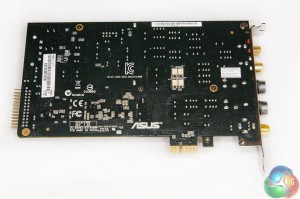
The Asus Essence STX II 7.1 Sound Card is built using the highest grade components. It measures 168 mm x 107 mm (LxW).
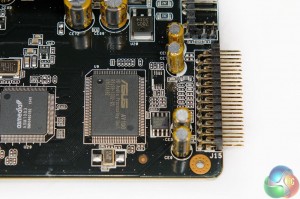
The Essense STX II includes a temperature compensated crystal oscillator (TCXO) clock source to deal with temperature changes and to ensure ultra low jitter.
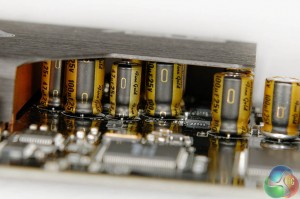
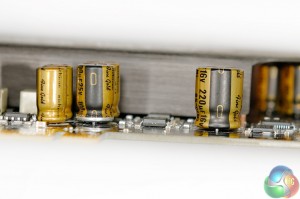
ASUS have not skimped on the board design, using highest grade audio Nichicon GOLD capacitors.
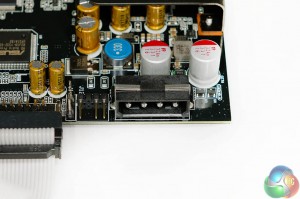
The card has to be powered via a MOLEX header, otherwise it won't work.
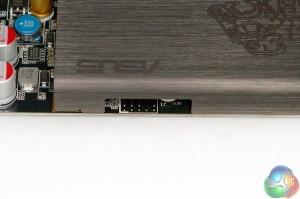
You can connect a front audio header directly to the card, shown above.
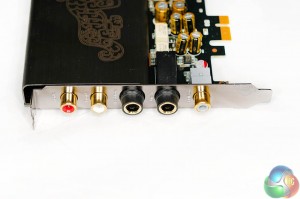
There is a Front R, Front L, Headphone, Line IN and SPDIF out connector along the side of the Essence STX II 7.1.
No skimpy 3.5mm jack either, this is a fully fledged 6.3mm single ended connector to suit high end headphones. Asus do supply a 6.3mm to 3.5mm adapter however, if you are using cheaper pair of gaming headphones.
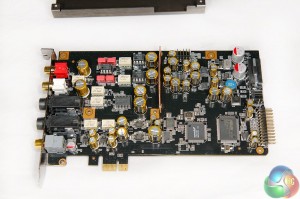
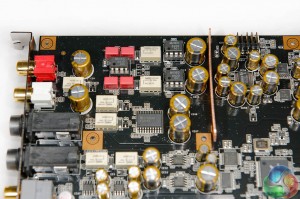
When the primary sink is removed, you can get a better overview of the PCB layout.
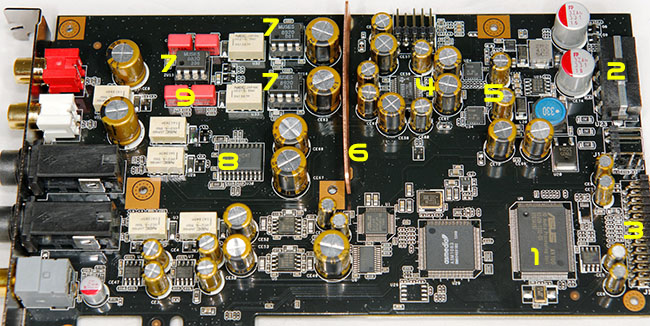
So what exactly is on the Asus Essence STX II 7.1 Sound Card? Above is our breakdown of the components ASUS are using.
1: Premium TXCO clock source.
2: The Molex power connector
3: Daughter card bridge connector
4: The Supreme Ti Burr Brown PCM 1792A Digital to Analog converter.
5: High fidelity LDO regulator
6: Shielding plate
7: MUSES Op-Amps (removable)
8: TI TPA6210A2 headphone amplifier
9: Professional WIMA capacitors.
We include some super high resolution images of the PCB layout of the hardware on the next page, so be sure to check them out if you want a more detailed view.
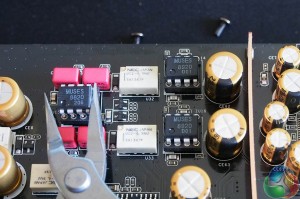
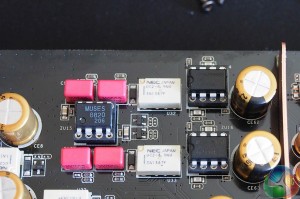
The main Essence STX II card has removable OP-AMPS, shown above. In the box are a set of other OP-AMPS which can be fitted to change the sound signature. ASUS include 2 x LME 49720 and a single MUSES 8820 OP AMP. Asus fit the MUSES 8920 OP AMP's as standard (above left) – a wise move, as (to my ears) they sound superior to the LME OP AMPS (above right).
Again audio is very much subjective and it is certainly a bonus that ASUS are including another set of OP AMPS to cater to a wider audience who like to tweak their setup.
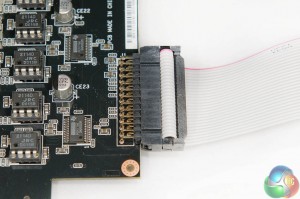
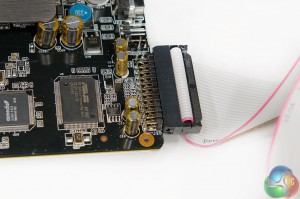
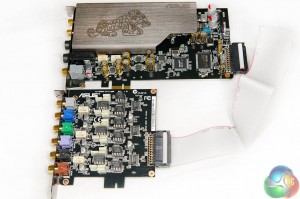
What looks like an old fashioned IDE cable in the box, is used to ‘bridge' the connection between the main card and the daughtercard. ASUS include a long enough cable to suit PCI Express positioning on any motherboard.
On this page we present some super high resolution images of the product taken with the 24.5MP Nikon D3X camera and 24-70mm ED lens. These will take much longer to open due to the dimensions, especially on slower connections. If you use these pictures on another site or publication, please credit Kitguru.net as the owner/source.
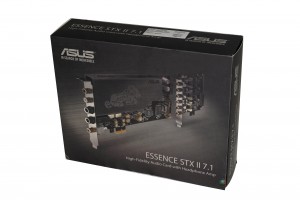
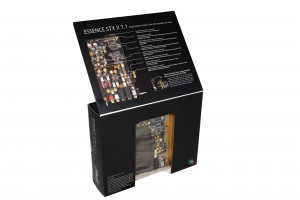
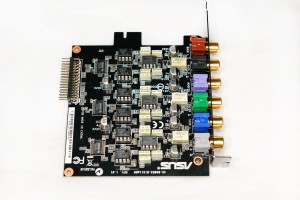
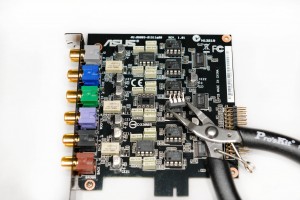
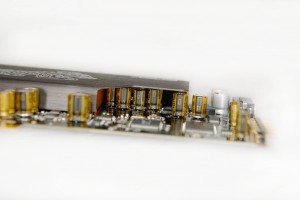
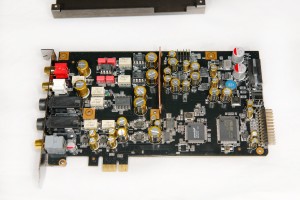
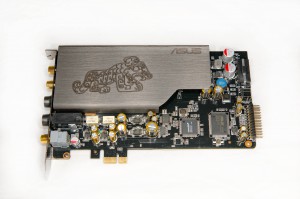
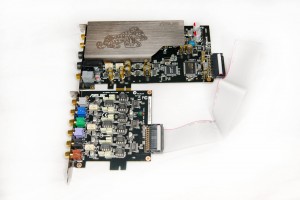
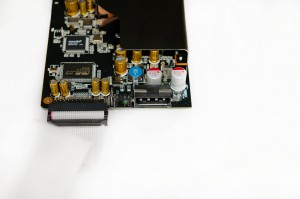
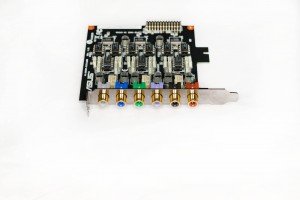
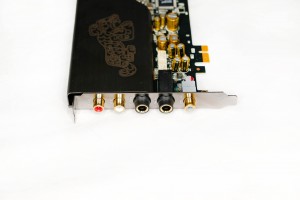
The test system we used today is listed in detail on this page.
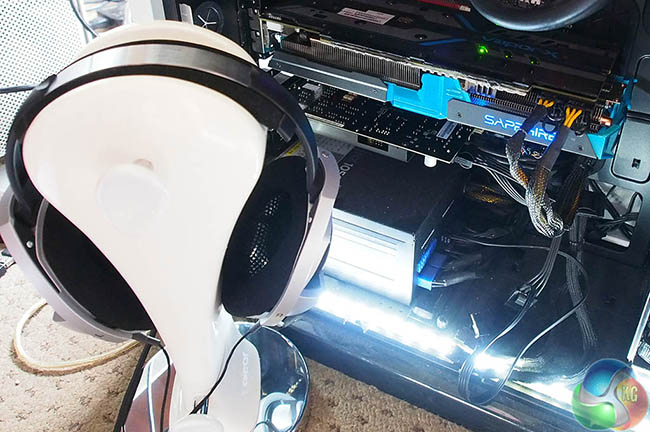
It uses an ASUS Maximus VI Hero Z87 motherboard.
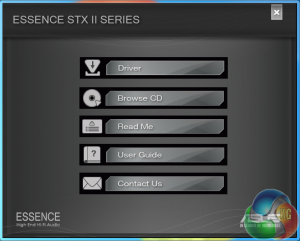
Setting up the Asus Essence STX II is straightforward. Simply connect the Molex cable, insert into a free PCI Express slot and start up the system. Insert the bundled software disc and install the drivers.
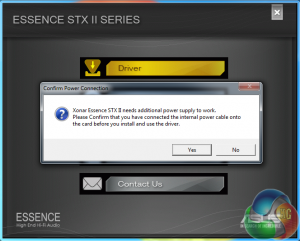
It is critical to connect a Molex header, or the sound card will not work at all. The software warns about this, just before the install starts.
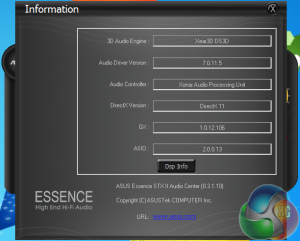
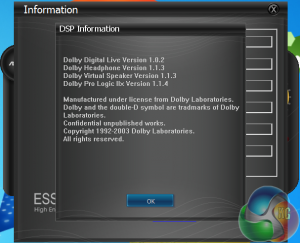
After a few minutes, the driver is installed and it is possible to check the revisions, shown above.
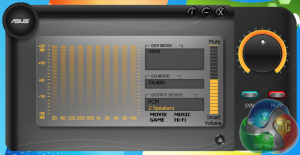
After a reboot, the software worked without a hitch. Not something we always say about ASUS software, which has a bit of a reputation for being ‘clunky' and temperamental. The main panel shows an output graph, volume control, SVN and Mute control and a series of presets for Movie, Music, Game and Hi-Fi.
The Asus Essence STX II has full support for:
Analog Playback Sample Rate and Resolution :
44.1K/48K/96K/192KHz @ 16bit/24bit
Analog Recording Sample Rate and Resolution :
44.1K/48K/96K/192KHz @ 16bit/24bit
S/PDIF Digital Output :
44.1K/48K/96K/192KHz @ 16bit/24bit
ASIO Driver Support :
44.1K/48K/88.2K/96K/176.4K/192KHz @ 16bit/24bit
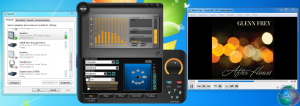
We tested with a variety of 24 bit 96khz/192khz FLAC files, downloaded from HDTRACKS and Linn Records. We had no problems getting the system to correctly decode the audio tracks.
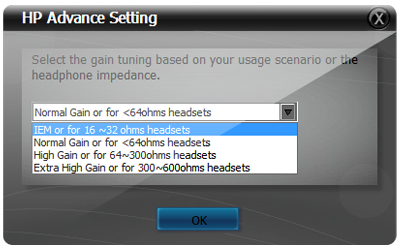
The Asus Essence STX II software has options to suit a variety of headphones, from easy to power <64 ohm drivers, to difficult to power 600 ohm drivers, such as those featured in the Beyerdynamic T1 Tesla.
We spent around 10 days in total testing the Asus Essence STX II 7.1 card, with flagship headphones. We also paired the system up with Corsair Gaming SP2500 speakers, available from Overclockers UK at £169.99 inc vat – these are directly connected to one of my systems at home. That said, we won't be focusing on these speakers today as they are not simply good enough to warrant a thorough analysis of the audio capabilities of the sound card. That said, the overall sound quality was certainly acceptable.
I don't use 7.1 speakers at all …. therefore cannot thoroughly test the 7.1 capabilities of the Essence STX II sound card.
All tests were ran with the MUSES OP-AMPS in the ASUS Essence STX II as to my ears … and with all the equipment I used, they sounded superior.
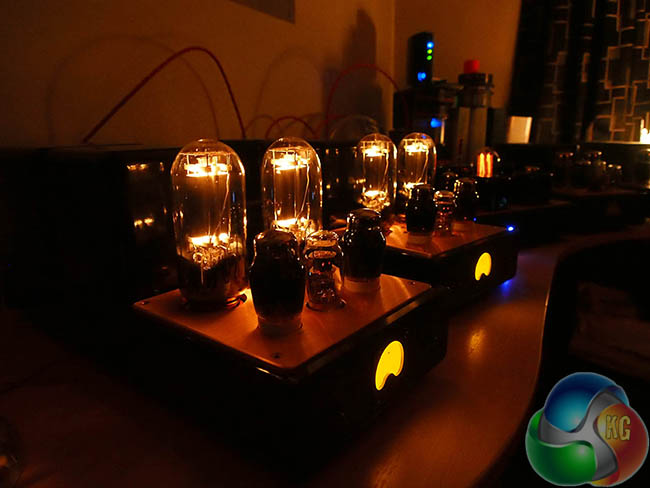
My home setup is based around Audiovector Si3 Signature speakers (£4,000) paired up with an Icon Audio LA5 TX Preamplifier (£2,800) and Signature Version MB 845 MK IIm Mono blocks (£7,200). I also have a pair of Icon Audio MB 90 MK IIM MonoBlocks which are used to power other speakers in my house.

We connected the Asus Essence STX II via line out to the input on the Icon Audio LA5 TX PreAmplifier for testing via the AudioVector Si3 Signature speakers.
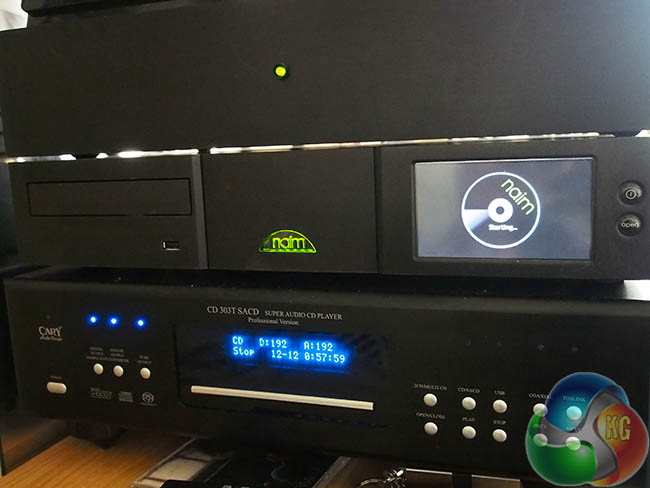
I used a variety of source material including (but not limited to) 24 bit files from Elton John, The Beatles, The Eagles, Eric Clapton, Herbie Hancock, Dawn Langstroth, Diana Krall, David Bowie, David Crosby, Jackson Browne, R.E.M., Queen (2011 SACD remasters), James Taylor, Jean Michel Jarre, Mike Oldfield, Glenn Frey, Michael Jackson, Otis Redding, Phil Collins, Pretenders, Norah Jones, Rush, Ry Cooder and Seal.
We compared alongside a NAIM HDX (with custom power unit) (£9,000 in total) and a Cary SACD 303T Professional Player (£4,000).
The Essence STX II was surprisingly capable, even when paired up with £15,000 of amplifier and speakers.
Mike Oldfield's superb 24 bit version of Ommadawn was a fantastic experience. The diverse instrumental piece delivered plenty of emotional impact – accurately presenting the densely overlayed guitar tracks in all its glory. The haunting vocal arrangement was presented magically – although the presentation was not quite as dramatic as the SACD when played via the Cary SACD 303T Player.
Bass lines were accurately rendered, and female vocals on Diana Kralls ‘The Girl In The Other Room' had plenty of body, capturing her breathless vocal style beautifully.
Phil Collins 24 bit album Face Value sounded fantastic via the Asus Essence STX II – the iconic track ‘In the Air Tonight' created a huge sound scape through the Icon Audio Valve equipment with the famous drum sequence at 3.15 literally shaking the floor boards.
There is no doubt that the Asus Essence STX II sound card is able to bat well above it's modest asking price. There are times when the presentation seems a little more ‘boxed' in, however it is worth pointing out again that we are comparing against playback sources between 20x and 40x more expensive.
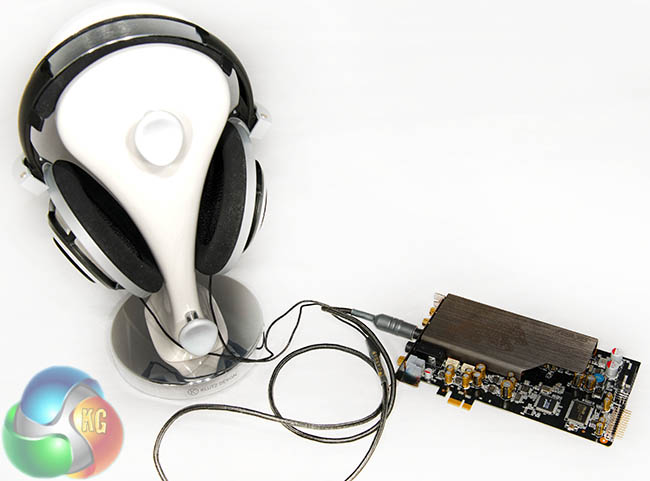
To test the Asus Essence STX II 7.1 today we used a series of headphones taken from our ‘Best Headphones money can buy – 2014‘ published a short while ago.
We focused on the excellent Sennheiser HD800 headphones, as it can be a tricky headphone to power properly, featuring a 300 ohm impedance. We are using a CARDAS Clear Light Headphone cable with the HD800 headphones (£330).
The Asus Essence STX II has a very capable headphone amplifier section. The only headphone they struggled with were the exceptionally difficult to drive HIFI MAN HE6 (Planar Magnetic). We discussed these headphones in detail, on this page.
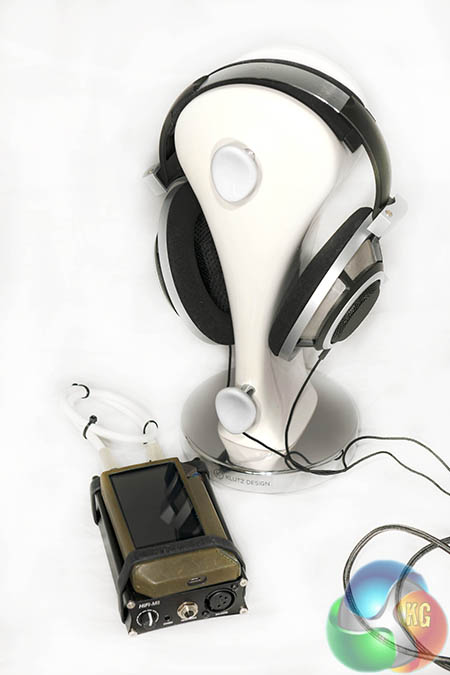
As a means of comparison we tested against the Astell and Kern AK240 player (£2,200), with the Hi-Fi M8 LX Portable D-A Converter/Headphone Amplifier (£550). I was going to using the Sennheiser CH 800 S balanced XLR cable with the Hi-Fi M8 LX Amplifier (£250) but decided to keep the same CARDAS single ended cable to eliminate any minor audio differences between the cables.
I used a variety of source material including (but not limited to) 24 bit files from Elton John, The Beatles, The Eagles, Eric Clapton, Herbie Hancock, Dawn Langstroth, Diana Krall, David Bowie, David Crosby, Jackson Browne, Queen (2011 SACD remasters), James Taylor, Jean Michel Jarre, Mike Oldfield, Glenn Frey, Michael Jackson, Otis Redding, Phil Collins, Pretenders, Norah Jones, R.E.M., Rush, Ry Cooder and Seal.
SEAL's ‘Crazy' brought back some memories from my youth. The 24 bit FLAC file sounded very bright on the HD800 headphones and not quite as rich as on the Hi-Fi M8 LC Portable D-A amplifier. We realised we had the M8 LX bass setting on full, so reduced it to the lowest setting and they were almost equal in presentation. The Astell and Kern AK240 player is an exceptional (if expensive) portable player comprising dual CS4398 DAC's. Channel separation was obviously a little better – although only via specific source material.
The Asus Essence STX II struggled a little to compete against the AK240/Hi-FI M8 LX portable combo when dealing with complex 24 bit orchestral tracks such as the Mozart Symphonies 38-41 from the Scottish Chamber Orchestral, but considering the substantial cost overhead, the minor audio differences are easy to justify. There is always a law of diminishing returns when you spend a certain amount of money on audio equipment … but we live with that.
Jean Michel Jarre's 24 bit Oxygene album was another treat waiting in store later that day. Oxygene Part III and Part IV carried plenty of bass impact via the HD800's although we would need to tweak an equaliser setting on the PC to bring a little more ‘meat' to the presentation. The HiFi M8 LX with AK240 didn't suffer from the same minor problem.
We found that the Asus Essence was able to cope with a huge array of audio tracks, almost matching the AK240/Hi-Fi M8 LX in overall presentation, but on occasion with more complex orchestral tracks it would sound a little more ‘boxed' in – a similar experience with the speaker configuration we tested on the previous page.
There is no doubt that the Asus Essence STX II 7.1 could be classed as a bit of bargain. In the world of audiophile components the Essence STX II asking price of £218 is less than the cost of a high grade interconnect cable.
Asus have not skimped on the design of the STX II. They are using high grade components throughout and the adoption of the Burr Brown PCM1792A digital to Analog converter will prove very popular with the enthusiast audience.
Asus have incorporated swappable OP AMP's on both the main Essence STX II PCB , and the supplementary daughter card. Additionally, they include a pair of LME49720 OP AMPs and a single MUSES8820 for those who wish to tweak the sound characteristics to suit.
The headphone amplifier is very capable and was able to power most of the high end headphones at our disposal, including the 300 ohm Sennheiser HD800 which we used primarily for this review. The Grado PS1000 also sounded great with the amplifier and with the gain setting set to ‘Extra High' in the software, even the 600 ohm Beyerdynamic T1 sounded focused with plenty of bass clout.
Not many people will be pairing the Essence STX II up with a £15,000 tube amplifier setup, however we thought this configuration would expose any weaknesses. We were pleasantly surprised to find out that the Essence STX II has a very capable dynamic range, and can cope with a range of 24 bit audio tracks at a similar level to source equipment costing many thousands of pounds. There is a certain loss of ‘scale' compared to our Cary 303T Professional SACD player or Naim HDX player (with specialised power section), however we can't imagine many people will complain.
We found that it took a seriously high end system to expose any weaknesses with the STX II, and we doubt that many people spending just over £200 on a dedicated sound card will be disappointed.
If I was buying a sound card for my own rig, I would definitely have an Essence STX II powering my headphones.
Discuss on our Facebook page, over HERE.
Pros:
- Bargain pricing for the audio quality.
- 24 bit/192khz support.
- software is a step up for ASUS.
- OP AMPS can be swapped out.
Cons:
- Only Windows XP, 7 and 8 Support.
- Need to route an ugly Molex cable to power it.
Kitguru says: An excellent partner for a high end pair of headphones. Bargain pricing.

 KitGuru KitGuru.net – Tech News | Hardware News | Hardware Reviews | IOS | Mobile | Gaming | Graphics Cards
KitGuru KitGuru.net – Tech News | Hardware News | Hardware Reviews | IOS | Mobile | Gaming | Graphics Cards


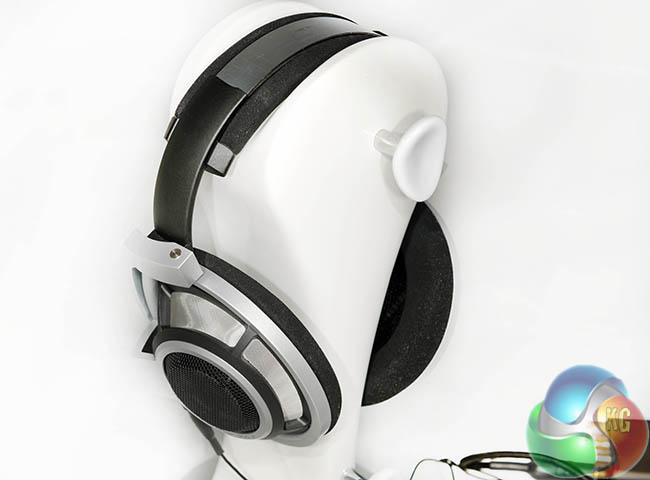
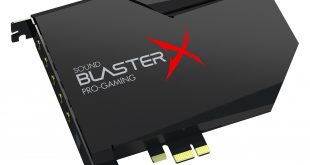
Really nice review you obviously put a lot of time into it.., it would be nice to see the difference when you connect this card to headsets and speaker systems in the enthusiast pricing range. I’m an audiophile too but unfortunately those nice valve mono blocks and headsets are a dream.
i found this card for 120 pounds on amazon, is it worth buying if i’m connecting it to a Corsair Vengeance 2100 Wireless Dolby 7.1 Gaming Headset and my Bose ® Companion ® 3 Multimedia Speaker System 2.1?
Many Thanks
Hi Anthony – without testing all the products you mention together it is difficult for me to give an answer. I did notice a marginal improvement when using my Corsair speakers over the integrated onboard sound on the ASUS Z87 motherboard. The headphone amplifier is really excellent, especially the gain options which can help drive ‘difficult’ headphones.
The good thing is, if you bought from Amazon and ended up not feeling it improved the experience, you can always return it under Amazon’s policy, without hassle. I would be curious to hear what you thought, if you bought it.
THE SAME SHIT SOFTWARE hahah they need to change it so bad
Great review